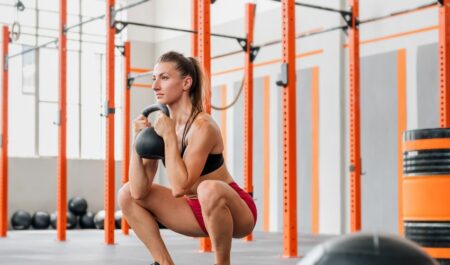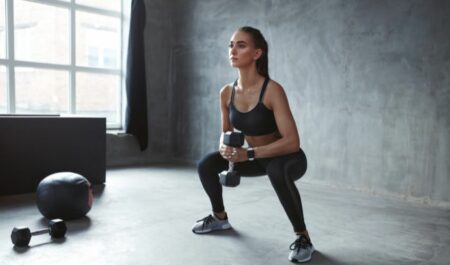The squat is a fundamental exercise that should be performed by anyone interested in developing their lower body strength. Alternate squat movements, such as the goblet squat, can be incredibly beneficial for both enhanced strength and injury prevention. Traditional back squats have lots of benefits, but mixing things up with alternative squat motions, such as the goblet squat, can really spice things up. Continue reading for more information about how to do goblet squat and what are the benefits of goblet squats.

Differences Between Goblet Squat And Back Squat.
The goblet squat and the back squat both engage a lot of the same muscles, yet the movements are very distinct from one another.
When performing a goblet squat, you will keep both hands on the weight and hold it in front of your chest. Your elbows will track between your knees as you descend into a squat, and the weight will follow after them.
A bar is racked on your upper back in order to perform a back squat. When you perform a squat, the bar will follow your downward movement and fall to the floor.
What Are The Benefits Of Goblet Squat?
Traditional back squats have a number of benefits, including the ability to help strengthen your back, but they also put you at danger for injuring your lower back, which is a disadvantage. This is because of the position of the load.
This strain can be alleviated by performing goblet squats, which also target the quadriceps and glutes, which are the primary movers during the exercise.
In addition to that, the motion itself is an excellent form of physical activity that is suitable for people of all fitness levels.
Additional advantages of performing goblet squats include the following:
Easier For Beginners.
A back squat is typically more difficult for novices to perform than a goblet squat. This is due to the fact that it is a more natural movement that resembles many activities that people do on a daily basis, such as picking up a heavy object from the floor.
A More Comfortable Position.
You should feel more at ease performing goblet squats than standard back squats because this variation of the exercise requires you to keep your torso straight, have a strong core, and push your legs outward. Read this article to learn how to perform squats with the correct form.
A Lighter Burden To Back.

When performing a typical back squat, the load is carried on the upper back, which places a significant amount of strain on the lower back. When performing a goblet squat, the load is brought forward to act as a counterbalance. This makes it easier for the spine to handle the load, and it also makes it easier to maintain the correct posture.
Activation Of The Extra Core.
Because the weight is now in front of your body rather than behind it, your abdominal muscles will have to work far harder to support the movement than they would in a standard back squat.
Potential To Scale.
You can begin goblet squats with a modest weight and still experience advantages from the action, but you can also raise a large load while performing this exercise. A word of caution is as follows: Make sure that you are able to complete the squat with the proper form and without experiencing any pain in the knees or back before moving on to a greater weight.
How to Do Goblet Squat?.
The goblet squat can be performed with either a dumbbell or a kettlebell. Your only constraints are the weights that you have access to, as well as your level of strength and flexibility.
Dumbbell Goblet Squat.

To perform a goblet squat with dumbbells, begin with a lighter weight and gradually increase it as you become more comfortable with the technique.
Way of Doing:
- Maintain a vertical grip on the dumbbell by positioning both hands so that they are underneath the top of the weight. Throughout the entirety of the exercise, the dumbbell should remain close to your chest.
- Make sure that your shins and knees are facing in the same direction.
- Take a deep breath in, and then begin to squat by sitting back in your hips while maintaining a tight core and an erect body.
- Move your elbows in a track between your knees and stop when they meet. This move is only possible if you have a high level of flexibility. If you find that touching your elbows to your knees leads you to lose your form, avoid doing so.
- Bring your feet all the way back to the starting position by driving through your heels. Keep your feet planted firmly on the ground during the entire movement, and steer clear of the temptation to raise your heels in an effort to bring your hips closer to the floor.
- Depending on your current fitness level and your desired outcomes, begin with two to three sets of ten to fifteen repetitions. It is important that the weight be difficult enough that you cannot complete even one more repetition while maintaining correct form.
- Between each set, take a short break of between 30 and 60 seconds.
Kettlebell Goblet Squat.
You should begin by using a kettlebell that isn’t too heavy until you get the hang of the movement.
Way of Doing:
- You should grasp the kettlebell firmly with both hands, either by placing them on the bottom of the bell (as illustrated) or on either side of the handle. Maintain a tight proximity to your chest with the kettlebell during the entire movement.
- Make sure that your shins and knees are facing in the same direction.
- Take a deep breath in, and then begin to squat by sitting back in your hips while maintaining a tight core and an erect body.
- Move your elbows in a track between your knees and stop when they meet. This move is only possible if you have a high level of flexibility. If you find that touching your elbows to your knees leads you to lose your form, avoid doing so.
- Bring your feet all the way back to the starting position by driving through your heels. Keep your feet planted firmly on the ground during the entire movement, and steer clear of the temptation to raise your heels in an effort to bring your hips closer to the floor.
- Depending on your current fitness level and your desired outcomes, begin with two to three sets of ten to fifteen repetitions. It is important that the weight be difficult enough that you cannot complete even one more repetition while maintaining correct form.
- Between each set, take a short break of between 30 and 60 seconds.
Instructions On How To Incorporate Goblet Squats Into Your Workout Program.
Performing a goblet squat as part of your workout program can be done in a few different ways.
Include the squat in your leg-focused workout together with the following exercises to improve your lower body strength:
- Deadlifts.
- Lunges.
- Traditional front squats.
Alternately, you might add a goblet squat to your full-body workout to provide some variety to the routine. Include the following in your regimen for a complete and balanced workout:
- Deadlifts.
- Rows.
- Chest presses.
- Planks.
Common Mistakes You Should Consider
During a goblet squat, two of the most common errors that people make are that they do not keep their backs straight and that their knees are in the incorrect position.
Your Torso Won’t Stay in an Upright Position.
If you do not have sufficient power in your abdominal muscles or flexibility in your ankles, you may find that as you squat down, your torso leans forward.
To combat this, maintain a strong core engagement throughout the action and keep the weight (either a dumbbell or a kettlebell) positioned as near to your torso as possible.
Your Knees Fall In (Or Out)
This is a typical error that people make when performing any kind of squat. Should either of your knees fall inwards or outwards, you put yourself at danger for sustaining a knee injury.
Your knees will cave inwards if you have weak hips or glutes. This will make walking and standing uncomfortable. In order to acquire correct form, you should keep your back straight while attempting to align your knees so that they point in the same direction as your toes.
Alternatives For Further Exploration.

You can target additional or different muscles by gently modifying the goblet squat or one of its many variations and trying one of the many goblet squat alternatives.
You can improve your ability to maintain a solid position by, for instance, employing a tiny resistance band right below your knees. This will help you develop the abductors in your hips, which are likely weak. It is important to remember to keep your knees in alignment with your toes while you work against the resistance of the band.
Squat With A Goblet As A Target.
The addition of a rotation or lunge at the bottom of the goblet squat is one way to increase the difficulty of the exercise.
- Carry out a goblet squat using the form described in the above sentences.
- Turn to the right when you reach the point when your thighs are parallel to the floor. To prevent putting unnecessary strain on your knee, rotate your entire left leg together with both hips.
- Bring your left knee down to the floor and rest it there. As you rotate into the lunge position, your left heel should come up higher.
- After you have completed the exercise in the opposite direction, stand up.
- Depending on your current fitness level and your desired outcomes, begin with two to three sets of ten to fifteen repetitions. It is important that the weight be difficult enough that you cannot complete even one more repetition while maintaining correct form.
- Between each set, take a short break of between 30 and 60 seconds.
Goblet Rear-Foot-Elevated Split Squat
Complete the goblet squat movement by bringing one foot behind you to an elevated position. This version will test your strength in one leg, as well as your balance and core strength.
Depending on your current fitness level and your desired outcomes, begin with two to three sets of ten to fifteen repetitions. It is important that the weight be difficult enough that you cannot complete even one more repetition while maintaining correct form.
Between each set, take a short break of between 30 and 60 seconds.
The Conclusion
Traditional back squats can be difficult on the back, but goblet squats are designed to be less stressful on the back while still giving many of the same benefits for the quads and glutes.
Consider doing this exercise instead of regular back squats or in addition to them for overall lower body strength. You can do this exercise either standing or sitting.
